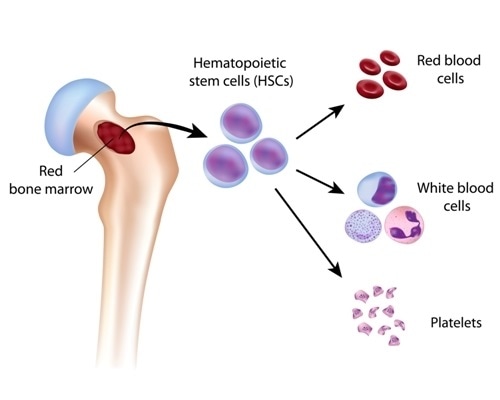Hematopoiesis is the process by which blood cells are created. The monophyletic theory on hematopoiesis, which is widely accepted, suggests that all of the hematopoietic cells are generated on the basis of pluripotent stem cells, which become unipotential ones and differentiate into precursor cells before going on to form mature blood cells.

Hematopoiesis during the early stages of embryogenesis occurs in the yolk sac and subsequently in the liver. During the 3rd to 7th month of gestation it primarily occurs in the spleen and just before birth shifts to the marrow cavity and from birth onwards occurs primarily in the bone marrow.
Pluripotent stem cells continuously produce more of themselves. Hematopoietic cells are constantly generated from pluripotent stem cells, where some of these pluripotent cells become unipotential stem cells. Subsequently, some of the cells of this unipotential population differentiate into precursor cells that, once differentiated, are in part committed to becoming one of the mature types of blood cells, which are erythrocytes, monocytes, lymphocytes, thrombocytes and granulocytes.
Hematopoietic cells that are immature precursor cells evolve from cells that make a lot of protein to cells that make less protein and structural changes occur with this evolution. These cells have more clumped or condensed chromatin, since it is not being actively transcribed. In addition to this, these cells have fewer nucleoli, smaller Golgi apparatuses, and fewer ribosomes, thus, they exhibit less basophilic hematoxylin staining.
Erythropoiesis
Erythropoiesis is the process by which red blood cells, also known as erythrocytes, are made and are stimulated by decreased levels of oxygen in the blood, which sets into motion the secretion of erythropoietin, a hormone central to the formation of red blood cells. The process of red blood cell formation takes on average 2 days to be completed from unipotential hematopoietic cell to mature red blood cell. In our bodies, there 2 million erythrocytes are produced every second. Hematopoietic cells committed to becoming red blood cells usually get smaller and more condensed as they mature until there is eventually loss of their nuclei.
The unipotential cell becomes what is known as a proerythroblast, which has a nucleus that is not condensed and takes up most of the cell with basophilic or blue cytoplasm. The cell then becomes a basophilic erythroblast, which is followed by a polychromatophilic erythroblast stage, where the nucleus is more condensed than the latter two stages and the cytoplasm becomes reduced. In the subsequent orthochromatophilic erythroblast stage, the nucleus is much smaller than that of the previous stages with a pinker cytoplasm. In the reticulocyte stage the red blood cell has no nucleus, but still stains somewhat blue due to the remnants of polyribosomes within the cell. Finally, the erythrocyte is the mature red blood cell, which has no nucleus and no polyribosome remnants and as a result stains pink.
Granulopoiesis
Granulopoiesis is the formation of granulocytes, which are white blood cells with multi-lobular nuclei and cytoplasmic granules. The unipotential hematopoietic cell that becomes a myeloblast is large and has a cytoplasm that stains blue with a large nucleus. This cell evolves into a promyelocyte that contains azurophilic granules, and then becomes a myelocyte, which has a non-indented still rather large nucleus. This cell then becomes a metamyelocyte, which is similar in size to a mature granulocyte and the nucleus begins to become indented. Following this stage is the band cell stage, where the nucleus has definitive indentation and resembles a horseshoe. Finally, there is the mature granulocyte, which has a lobed nucleus and cytoplasmic granules. The entire process happens over a period of 2 weeks.
Monopoiesis, Lymphopoiesis and Thrombopoiesis
Monopoiesis is the process by which monocytes are formed. The committed progenitor cell, the monoblast, is found only in the bone marrow and has a basophilic cytoplasm without granules. These evolve into promonocytes, which are smaller with nuclei that become slightly indented, before becoming monocytes, which have kidney-shaped nuclei and can develop into dendritic cells or macrophages.
Lymphopoiesis is the formation of lymphocytes, which start from their first committed progenitor cells, lymphoblasts. These cells go on to mature into lymphocytes that are capable of differentiating into either B, T or natural killer cells. Thrombopoiesis is the formation of platelets, which come from extremely large cells within the bone marrow called megakaryocytes. The creation of individual platelets occurs when the plasma membranes of megakaryocytes are fragmented, thereby generating platelets containing many granules.
Sources
- https://www.ncbi.nlm.nih.gov/pmc/articles/PMC3666375/
- https://medlineplus.gov/ency/anatomyvideos/000104.htm
- http://www.pathwaymedicine.org/hematopoiesis
- https://library.med.utah.edu/WebPath/HISTHTML/NORMAL/NORMAL16.html
- http://dev.biologists.org/content/develop/140/12/2463.full.pdf
Further Reading
- All Hematopoiesis Content
- What is Hematopoiesis?
Last Updated: Aug 23, 2018

Written by
Dr. Damien Jonas Wilson
Dr. Damien Jonas Wilson is a medical doctor from St. Martin in the Carribean. He was awarded his Medical Degree (MD) from the University of Zagreb Teaching Hospital. His training in general medicine and surgery compliments his degree in biomolecular engineering (BASc.Eng.) from Utrecht, the Netherlands. During this degree, he completed a dissertation in the field of oncology at the Harvard Medical School/ Massachusetts General Hospital. Dr. Wilson currently works in the UK as a medical practitioner.
Source: Read Full Article
